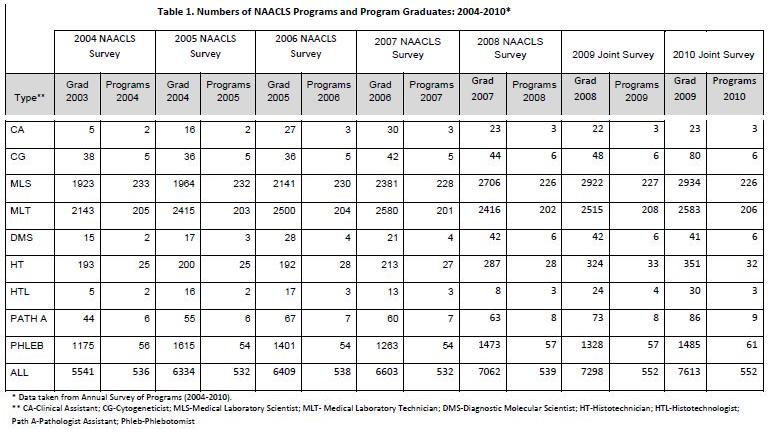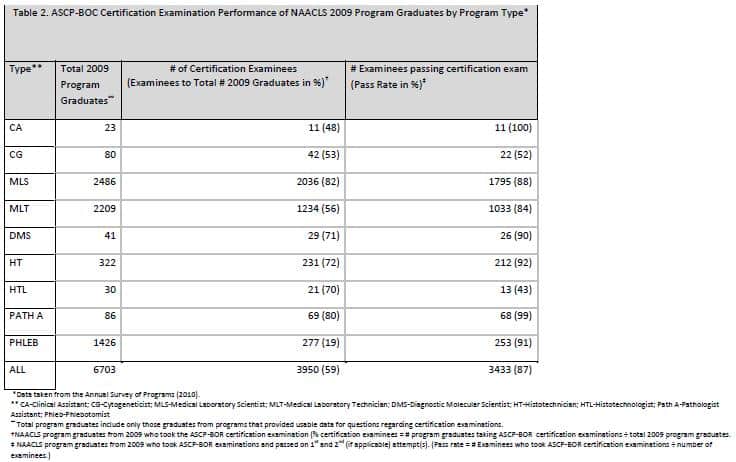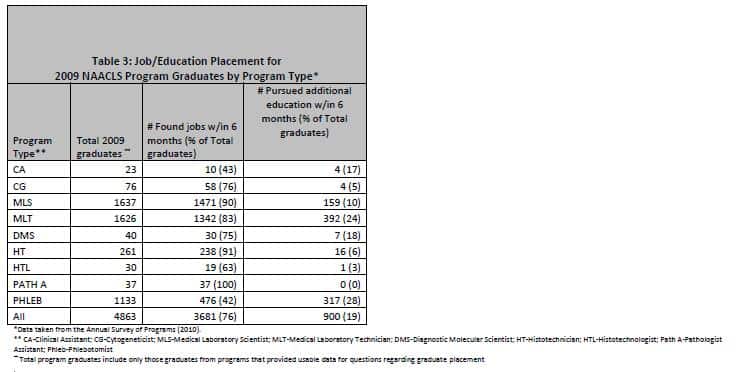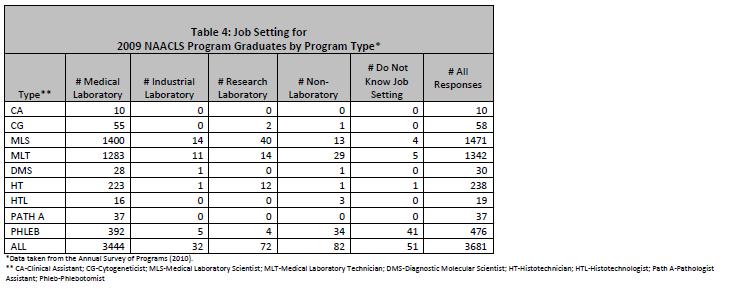NAACLS Programs, Graduates, Pass Rates and Placements: Findings From the 2010 Annual Survey of Programs
The Annual Survey of Programs, a collaborative effort of NAACLS, the ASCP-Board of Certification (ASCP-BOC), and the American Medical Association (AMA), was disseminated to program directors of 552 NAACLS accredited and approved programs. Submission of the completed survey is required annually by the Standards for NAACLS programs. Presented here are data indicating numbers of NAACLS accredited and approved programs and graduates, certification examination pass rates, and job and/or further education placement rates of graduates.
A longitudinal look at the numbers of programs and graduates by program type for the last 7 years appears in Table 1. Despite a change of one or two programs in each of the medical laboratory science (MLS), medical laboratory technician (MLT), histotechnician (HT), histotechnologist (HTL) and pathologist assistant (Path A) levels, the total number of programs in 2010 (552) was unchanged from 2009. In 2010, the number of phlebotomy (Phleb) programs increased over 2009 from 57 to 61 programs. Despite stability in the number of programs the number of graduates produced by these programs increased, with the exception of a statistically insignificant decrease in diagnostic molecular science (DMS) program graduates (42 in 2009: 41 in 2010). In some cases the increase in the number of graduates was striking as with the cytogenetics (CG) programs (48 in 2009; 80 in 2010). This increase in the numbers of graduates continues the trend observed with the 2009 survey. Once again the data suggest that, and anecdotal information supports, programs have increased enrollments through more effective student recruitment strategies, adaptations to education delivery models, and cultivation of clinical experience opportunities that allow greater numbers of students to complete programs.
The survey asked program directors to report on the number of graduates taking the ASCP-BOC certification examination and the number of examinees who passed on the first and second (if applicable) attempt(s) (Table 2). Of 7613 graduates from NAACLS accredited and approved programs in 2009 (see Table 1), the pass rate data reported in Table 2 reflect only 6703 of those. It should be remembered that graduates from NAACLS accredited and approved programs are not required to take certification exams for successful completion of programs. Some graduates choose to delay taking examinations or elect not to do so and thus the number of examinees is less than the total number of graduates. As well, some graduates chose to take alternative certifying examinations and these data are not captured. Further, examinees are not required to release examination scores to their respective programs so for these examinees there are no available data. Of 552 accredited or approved programs, 420 responded to the questions regarding certification examinations with usable data. As seen in Table 2, 3950 examinees of 6703 graduates (59%) took an ASCP-BOC certifying examination with the highest percentages of ASCP-BOC examinees reported from MLS (82%) and PATH A (80%) programs and the lowest from phlebotomy programs (19%). The low percentage of phlebotomist examinees is probably the result of multiple phlebotomist certification examinations offered by different organizations and few or no employment consequences for the lack of professional credentials by phlebotomists. The reported pass rates for examinees from all program types were 84% or higher, with the exception of CG and HTL programs (52% and 43%, respectively). For these two program types it should be noted that the small number of programs and graduates makes statistical analyses not dependable.
Program directors were asked to provide the numbers of graduates who found employment positions and/or pursued additional education within six months (Table 3). Also asked was the setting for employment positions of graduates including medical, industrial or research laboratories, non-laboratory settings or “do not know” (Table 4). For Tables 3 and 4, error checking eliminated programs for which the answers to these questions could not be reasonably matched with responses to other survey questions, leaving the inclusion of data from 335 of the 552 programs that were surveyed. For MLT program graduates the percentages of graduates who secured employment and pursued additional education exceeded 100% suggesting that some graduates are both working and continuing their educations (Table 3). The percentages of graduates employed within six months ranged from a high of 100% for graduates of pathologist assistant programs to a low of 42% for phlebotomy program graduates with most program levels reporting placement rates of 75% or higher. Medical laboratory technician and phlebotomy programs reported the highest percentages of graduates pursuing additional education (24 and 28%, respectively) while pathologist assistants programs reported no graduates pursuing additional education. The employment setting for a large majority of graduates of NAACLS programs is within medical laboratories, as expected, but some found employment in alternative settings.
In summary, the number of NAACLS accredited and approved programs remains stable but the numbers of program graduates increased. Delays in retirements triggered by the economic recession may have eliminated some employment positions or slowed the filling of open positions but the acute national shortage of clinical laboratory professionals and greater demands for healthcare services have created the need for increased numbers of new laboratory professionals. Programs appear to have responded to that need by expanding enrollments. A significant percentage of new graduates did not take an ASCP-BOR certification examination, took alternative examinations, chose not to share examination results with programs, or were uncounted due to errors in completing the survey. For most program levels, the pass rates for examinees was above 80% indicating that programs are not only producing larger numbers of graduates but that these graduates are educationally well prepared. The placement rates for most program levels were 75% or higher with the majority of employed graduates working in medical laboratories. Findings from the annual survey yielded snapshots about programs, graduates, certification examination pass rate percentages, placement rates, and settings in which graduates find employment. NAACLS, the ASCP-BOR, and the AMA will continue efforts to refine the annual survey such that program directors are minimally burdened by the task of completing the survey and the collected data are fully usable.
– Dr. Dianne Cearlock, NAACLS CEO
Program Directors please note: The 2011 Annual Survey of Programs should be disseminated by the time this publication is posted on NAACLS website.
Please watch for it!



